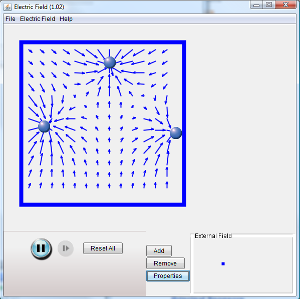As we begin Electricity and Magnetism, we want to investigate properties of electric charges and the electric fields they create at all points in space around the charge. Before we formally spell out the properties of charge and the standard interpretations of those properties, it is more fun and educational for you to 'discover' the properties on your own if at all possible. We will try a PhET simulation for you to use, and you can perform computer experiments to try and figure out some features of charges and fields based on your observations.
When using the 'Electric Field of Dreams' simulation, you can add electric charges with the Add button, and with properties play with adding both negative and positive charges. By clicking on the Electric Field option at the top of the simulation window, you can set the E-field discreteness, which adds more field arrows to help you easily see what the fields look like from each charge. Try to observe so you can answer the following questions:
- In which direction do the electric field vectors point for a positive charge? For a negative charge?
- What direction does an External electric field push a negative charge? A positive charge?
- What determines how strong the electric force is between two charged particles?
Record your observations and answers to the above questions in your lab book. There is also an ActivPhysics simulation you should open and run. It is about the electric fields from point charges (number 11.4, Electric Field: Point Charges). Work through the lesson, using the simulations to make observations and to answer questions presented in the lesson. Also take advantage of the Advisor option in ActivPhysics, so you can compare your thoughts with the correct responses. This will provide a nice 'second opinion' to the PhET simulation. Again, focus on observations of E-field and force vectors relative to positive and negative charges. You want to try to convince yourself of how this all works based on your observations and not so much on Doc V in class! :-)
Wednesday, September 11, 2013
Subscribe to:
Post Comments (Atom)

No comments:
Post a Comment
Note: Only a member of this blog may post a comment.